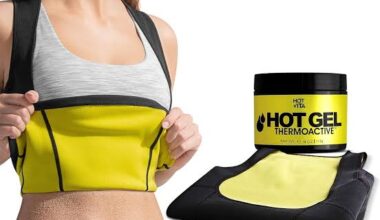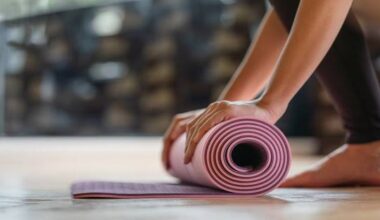Any Yoga enthusiast knows that choosing or finding the right Yoga Mat and accessories like blocks and straps are crucial for providing support during a yoga practice.
Are you a lover of Yoga, and are having challenges choosing the right Yoga Mat? Don’t worry, this Cork Vs Rubber Yoga Mat review delves into their unique properties, grip levels, comfort factors, and eco-friendliness to help you decide which mat perfectly complements your practice.
Yoga is a practice that offers the potential for balance between the mind and body, increased flexibility, and perhaps a fresh feeling of inner peace.
However, before you embark on your journey to enlightenment through downward-facing dog poses, it’s important to carefully choose the right yoga mat.
Think of your mat as the foundation for your practice. It’s where you’ll find stability during challenging poses, sweat it out during vinyasas, and hopefully, achieve those coveted moments of inner peace. But with a plethora of materials, thicknesses, and styles available, choosing the right yoga mat can feel overwhelming.
Do not worry, dear yoga enthusiasts! This comprehensive guide will examine the top contenders in the environmentally friendly yoga mat market: Cork and Rubber. We will explore their distinct characteristics, levels of grip, comfort, and eco-friendliness to assist you in choosing the ideal mat for your practice.
Let’s Dive in!
What is Yoga?

Yoga is an ancient practice that originated in India thousands of years ago. It’s a multifaceted discipline that goes beyond just physical postures (asanas). Here’s a breakdown of its core aspects:
- Physical postures (asanas): This is what most people think of when they hear “yoga.” Asanas involve various stretching and strengthening poses designed to improve flexibility, strength, balance, and coordination.
- Breathing techniques (pranayama): Pranayama focuses on controlling the breath to improve lung function, reduce stress, and enhance overall well-being.
- Meditation (dhyana): Meditation practices aim to quiet the mind, cultivate focus, and achieve a state of inner peace.
- Relaxation (shavasana): Yoga incorporates relaxation techniques to allow the body and mind to fully integrate the benefits of the practice.
- Philosophy: Yoga is steeped in philosophy, particularly those from Hinduism and Buddhism. These philosophies explore concepts like self-awareness, detachment from material possessions, and the connection between the individual and the universe.
While the traditional goals of yoga revolved around spiritual enlightenment, modern yoga practices often emphasize the physical and mental health benefits. It’s become a popular form of exercise that can help reduce stress, improve flexibility, and promote overall well-being.
People also read: Yoga-Go Reviews: Is Yoga-Go Legit? Pros, Cons, Features, And Pricing
Why Do I Need A Yoga Mat?
No matter what style of yoga you do or whether you’re a novice or a seasoned practitioner, it’s important to find the perfect yoga mat to support your practice.
A suitable mat offers a secure and comfortable space, providing stability and enhancing your overall yoga experience.
Having your own mat, whether at home or in a studio, ensures cleanliness and creates a familiar environment for you to fully engage in your practice.
Whether you enjoy gentle restorative yoga, dynamic vinyasa flows, or challenging Ashtanga sequences, having your own yoga mat allows you to feel at ease, supported, connected, and free from distractions during your practice.
Yoga mats can assist in reducing the risk of injury by helping yogis maintain a strong grip on the surface during poses, thus preventing slipping and offering additional cushioning for sensitive knees or joints.
Having your own yoga mat ensures a consistent and clean workout space, regardless of the style of yoga you practice.
Cork vs Rubber Yoga Mat | Full Review
When purchasing a yoga mat, it is crucial to consider the material as it determines the texture, comfort, durability, and eco-friendliness of the mat. The material chosen will also impact the weight, price, and grip of the mat. PVC, natural rubber, TPE, and cork are the most commonly used materials for yoga mats.
However, for this discourse, we are considering only Cork Vs Rubber Yoga Mat!
1. Cork Yoga Mat
Crafted from the bark of cork oak trees, cork yoga mats boast a luxurious feel and a surprising number of benefits.
Cork is an extremely sustainable choice for your yoga mat as it is made of 100% biodegradable material.
Cork yoga mats become more grippy as you sweat, and they are highly durable, offering the ideal combination of cushioning and traction for your yoga practice.
Cork is naturally antimicrobial, which means it helps keep your space clean and hygienic while you use it.
Advantages of Cork Yoga Mat
- Eco-Friendly Champion: Cork is a champion of sustainability. The bark regenerates naturally, meaning no trees are harmed during production. Plus, cork is biodegradable and recyclable, minimizing its environmental footprint.
- Grip Like a Gecko (When Wet): While cork provides a smooth, comfortable surface for dry practices, its magic truly shines when wet. The material becomes incredibly grippy, preventing slips and slides during sweaty vinyasa flows.
- Naturally Antimicrobial: Cork boasts natural antimicrobial properties, making it a hygienic choice. This is especially beneficial for yogis who practice frequently or share studio mats.
- Supportive and Stable: Cork offers a medium level of cushioning, providing excellent joint support during poses. The material’s firmness also enhances stability for balance-focused asanas.
Disadvantages of Cork Yoga Mat
- Costlier Companion: Compared to rubber mats, cork can be a pricier option. However, its durability and eco-friendly nature may justify the investment for some yogis.
- Not as Foldable: Unlike rubber mats, cork isn’t as easily foldable. This might be a concern for those with limited storage space.
- Break-In Period: Some users report a slight break-in period for cork mats. The surface may feel slightly slick initially, especially for dry practices.
See Also: Organic Fit Reviews: Is Organic Fit App Legit? Features, BENEFITS And Pricing
2. Rubber Yoga Mat
Natural rubber yoga mats have been a mainstay in studios for years and good reason.
Natural rubber yoga mats are made of a non-toxic and durable material, which is also biodegradable. They are heavier than non-rubber yoga mats and often have a firmer surface, which may not provide as much comfort for sensitive knees.
While natural rubber provides excellent grip for a non-slip mat, it can be too sticky for certain poses such as forward splits or jump-throughs.
Additionally, rubber yoga mats can become slippery with sweat and are not recommended for hot yoga classes.
Advantages of Rubber Yoga Mats
- Unwavering Grip: Rubber is renowned for its exceptional grip, both wet and dry. This makes it a popular choice for all types of yoga practices, from gentle Hatha to dynamic Ashtanga.
- Plush Comfort: Rubber mats offer excellent cushioning, providing a soft and comfortable surface for your joints, especially during floor poses or practices focused on deep stretches.
- Highly Durable: Rubber is known for its exceptional durability. With proper care, a high-quality rubber mat can last for years, making it a long-term investment.
- Wide Range of Options: Rubber mats come in a variety of thicknesses, textures, and colors. This allows yogis to find a mat that perfectly suits their needs and preferences.
Disadvantages of Rubber Yoga Mats
- Potential for Allergies: People with latex allergies should avoid natural rubber mats. Opt for a TPE (thermoplastic elastomer) mat, a synthetic alternative that offers similar properties.
- Strong Initial Odor: New rubber mats can have a strong odor. This usually fades over time, but it’s worth considering if you have a sensitive nose.
- Heavier Weight: Compared to Cork, rubber mats are typically heavier. This might be a concern for yogis who carry their mats to and from classes.
Cork Vs Rubber Yoga Mat | Which is the Best Mat?
There’s no such thing as the “best” mat – the ideal choice depends on your individual needs and preferences. Here’s a breakdown to help you decide:
Choose Cork if:
- Sustainability is your top priority.
- You practice hot yoga or vinyasa flows with a lot of sweat.
- You prefer a naturally antimicrobial surface.
- You value a medium level of cushioning and stability.
Choose Rubber if:
- You prioritize exceptional grip for all types of practices.
- You crave maximum comfort and joint support.
- You’re looking for a durable mat that will last for years.
- You appreciate a wide variety of thickness and texture options.
Things to look out for when choosing Yoga Mats
1. Yoga Mat Material:
PVC, natural rubber, TPE, and cork are the most commonly used materials for yoga mats.
2. Yoga Mat Thickness:
The thickness of your yoga mat is the second most important factor to think about before buying, and it varies depending on the type of yoga you do. Standard thickness usually begins at approximately 1/8 inch or 3mm, while thicker yoga mats are ¼ inch or 6mm thick.
The thickness of a yoga mat impacts its comfort level, but there are other factors to take into account before purchasing the thickest option available. While a thicker yoga mat can provide joint support, selecting an excessively thick mat may impede your movements and could be overly soft, leading to instability as you sink into the mat.
Thinner yoga mats (less than 3mm) are commonly found as travel yoga mats. Although these mats are convenient to store and transport between your home and class, they may not offer much cushioning, especially when practicing on hard floors.
The ideal thickness for a yoga mat is typically between 3mm and 4mm. Mats within this range offer a good balance of support for maintaining stability and comfort. They are also thin enough to be conveniently portable.
3. Yoga Mat Texture
Texture is another important factor to take into account when selecting your yoga mat as it impacts the overall comfort and grip of the mat. The texture plays a role in determining the level of traction the mat offers during your workout.
PVC mats have a slightly textured surface that offers grip to prevent slipping and helps maintain proper alignment during your practice.
4. Price
Yoga mats are available at a wide range of prices to accommodate different budgets and preferences. While basic PVC mats made from synthetic materials can be relatively cheap, typically ranging from $10 to $30, more premium options made from natural materials such as rubber, cork, or eco-friendly TPE tend to be more expensive, usually ranging from $50 to $150 or even higher.
The cost of a yoga mat often indicates its quality, durability, and sustainability, with higher-priced mats generally offering better grip, cushioning, and longevity, which are important for regular use.
However, there are also affordable options that provide sufficient support and functionality for beginners or occasional practitioners.
Ultimately, it’s important to find the right balance between price and quality when choosing a yoga mat that meets your needs and budget.
5. Eco-Friendliness
For many yogis, owning an environmentally friendly yoga mat is crucial.
Conventional PVC mats and other harmful yoga mats frequently contribute to the long-term clogging of landfills, despite being a popular choice for many yoga studios, they are not eco-friendly.
We believe that the ideal blend for an environmentally friendly yoga mat consists of natural rubber and cork, both of which are natural materials and biodegradable.
Cork is considered one of the most sustainable materials due to its ability to regenerate itself, thus avoiding harm to trees during the production of cork yoga mats. Additionally, cork can be recycled without generating any toxic residues.
Is There Any Hybrid Between Cork and Rubber Yoga Mats?
Can’t decide between cork and rubber? Fear not! Many brands offer hybrid mats that combine the best of both worlds. These mats typically feature a natural rubber base for stability and grip, with a cork top layer for a luxurious feel and increased traction when wet.
Final Thought | Cork vs Rubber Yoga Mat
Ultimately, the best way to choose your yoga mat is to try it before you buy. If possible, visit a yoga studio or equipment store and test out different materials and thicknesses.
Pay attention to how the mat feels under your hands and knees, and consider how much cushioning and stability you need for your practice.
Remember, your yoga mat is your personal sanctuary. Invest in a mat that makes you feel comfortable, supported, and ready to conquer those downward-facing dogs with confidence.
With the right choice by your side, you’ll be well on your way to unrolling a practice filled with peace, strength, and maybe even a touch of zen.
References
Disclaimer: This review is based on user experiences and factual information available at the time of writing. Prices and features may vary. Always check the app’s official website for the latest details.






